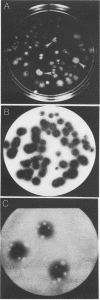Abstract
Botulinal neurotoxin in and around colonies of Clostridium botulinum types A, B, and E and of toxigenic Clostridium butyricum was detected by an enzyme-linked immunoassay procedure whereby the toxin was transferred from the agar medium to a nitrocellulose support and the immobilized toxin was probed with type-specific antibodies. The method identified the toxin types of the colonies grown from a mixed inoculum of C. botulinum serotypes. The specificity of the antitoxins for type A and B toxins was improved by adsorption of the antitoxins with the antigens of heterologous type cultures.
Full text
PDF



Images in this article
Selected References
These references are in PubMed. This may not be the complete list of references from this article.
- Boroff D. A., Fleck U. Statistical analysis of a rapid in vivo method for the titration of the toxin of Clostridium botulinum. J Bacteriol. 1966 Nov;92(5):1580–1581. doi: 10.1128/jb.92.5.1580-1581.1966. [DOI] [PMC free article] [PubMed] [Google Scholar]
- Dasgupta B. R., Sugiyama H. Molecular forms of neurotoxins in proteolytic Clostridium botulinum type B cultures. Infect Immun. 1976 Sep;14(3):680–686. doi: 10.1128/iai.14.3.680-686.1976. [DOI] [PMC free article] [PubMed] [Google Scholar]
- Dezfulian M., McCroskey L. M., Hatheway C. L., Dowell V. R., Jr Selective medium for isolation of Clostridium botulinum from human feces. J Clin Microbiol. 1981 Mar;13(3):526–531. doi: 10.1128/jcm.13.3.526-531.1981. [DOI] [PMC free article] [PubMed] [Google Scholar]
- Giménez J. A., Sugiyama H. Simplified purification method for Clostridium botulinum type E toxin. Appl Environ Microbiol. 1987 Dec;53(12):2827–2830. doi: 10.1128/aem.53.12.2827-2830.1987. [DOI] [PMC free article] [PubMed] [Google Scholar]
- Notermans S., Dufrenne J., Schothorst M. Enzyme-linked immunosorbent assay for detection of Clostridium botulinum toxin type A. Jpn J Med Sci Biol. 1978 Feb;31(1):81–85. doi: 10.7883/yoken1952.31.81. [DOI] [PubMed] [Google Scholar]
- Somers E., DasGupta B. R. Clostridium botulinum types A, B, C1, and E produce proteins with or without hemagglutinating activity: do they share common amino acid sequences and genes? J Protein Chem. 1991 Aug;10(4):415–425. doi: 10.1007/BF01025256. [DOI] [PubMed] [Google Scholar]
- Tse C. K., Dolly J. O., Hambleton P., Wray D., Melling J. Preparation and characterisation of homogeneous neurotoxin type A from Clostridium botulinum. Its inhibitory action on neuronal release of acetylcholine in the absence and presence of beta-bungarotoxin. Eur J Biochem. 1982 Mar 1;122(3):493–500. [PubMed] [Google Scholar]
- Tsuzuki K., Yokosawa N., Syuto B., Ohishi I., Fujii N., Kimura K., Oguma K. Establishment of a monoclonal antibody recognizing an antigenic site common to Clostridium botulinum type B, C1, D, and E toxins and tetanus toxin. Infect Immun. 1988 Apr;56(4):898–902. doi: 10.1128/iai.56.4.898-902.1988. [DOI] [PMC free article] [PubMed] [Google Scholar]





